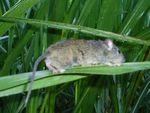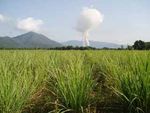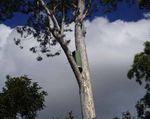Rat management in sugarcane
←
→
Page content transcription
If your browser does not render page correctly, please read the page content below
Information Sheet
IS13114
Rat management in sugarcane
Introduction
Two species of rat cause the most damage to sugarcane in
central and northern cane districts, resulting in significant
loss to both sugar content and tonnes of cane if they are not
managed. Both species are native grassland animals and are
protected under the Nature Conservation Act 1992.
Species description, biology and damage
Canefield or ground rat (Rattus sordidus)
The canefield or ground rat is found mainly on the east coast of
Australia from Cape York to northern New South Wales. It is a
severe pest in sugarcane areas from Mackay to Mossman, with
the exception of the Burdekin district. It occurs less commonly
in the southern cane growing areas.
The ground rat can measure up to 200 mm in length and weigh
up to 250 gm. It is a dark coloured rodent with a coarse, spiny
coat, dark-brown to black in colour with grey streaks (Photo
1). Black hairs as long as 45 mm are present on the rump. The
belly fur is light greyish-yellow. The tail is dark brown to black,
is usually shorter than the head and body, and has pronounced
scale rings. The ears are a light grey colour and females have
five pairs of teats.
Ground rats dig many burrows with tunnels 5-10 cm in
diameter (Photo 2). The tunnels often slope downards to a Photo 1: Ground or canefields rat.
nesting chamber about 15 cm in diameter which contains a bed
of dry grass. Burrow systems are usually no more than 40 cm
deep. Rats are using the burrows if ‘fresh’ soil is found around The population cycle of the ground rat closely follows the
the entrance holes. The burrows often follow cane rows, while sugarcane crop cycle (Figure 1):
in non-crop areas holes are found near grass clumps, stumps,
fence posts and large stones. As many as 23 rats may occupy a • M
ature, non-breeding individuals leave adjacent non-crop
single nest. harbourage areas and colonise developing crops during
November–January.
• F ollowing colonisation, an annual breeding period from
November to March is associated with the first appearance
of summer grasses in and around crops as a result of rainfall.
The main diet during the peak breeding is seed of summer
grasses. Breeding declines as seed becomes less available
and their diet switches to include more sugarcane.
• G
round rat populations disperse back to non-crop
harbourages as sugarcane crops are harvested. Re-
colonisation occurs in the following season between
Photo 2: Burrow of ground rat. November–January.
sugarresearch.com.auInformation Sheet
IS13114
Photo 4: Severe ground rat damage.
Figure 1: Breeding and damage cycle of ground rat. Climbing rat (Melomys burtoni)
Rat populations and subsequent damage to sugarcane, are
The climbing rat is also found along the coast from Cape York
highly correlated to the amount of weed cover in cane fields
to northern New South Wales, and also extends into the
and the proximity of favourable non-crop harbourage. Rats do
Northern Territory and north eastern Western Australia. The
not breed when only sugarcane is available for food.
most severe and widespread damage from climbing rats occurs
in the valleys growing cane within the wet tropics (Tully to
Ground rat damage (Photos 3 and 4) affects yield in two ways:
Mossman), however they may also cause damage to sugarcane
in parts of the Mackay, Proserpine and Herbert districts.
• Bitten stalks – reduces the tonnes of cane/ha.
The climbing rat (photo 5 and 6) is a smaller animal which
• S econdary attack by other pests – rat-bitten cane is prone
varies in colour. They measure up to 130 mm in length and
to attack by bacteria and fungi, and by insects such as
weigh up to 80 gm. Back colour varies from grey to red brown.
sugarcane weevil borer. This can result in a 15-20 per cent
Belly colour is white, grey or cream, sometimes grading to
loss of CCS.
pale orange on the sides. The tail of the climbing rat has a tile
pattern as opposed to the series of rings in the case of the
Losses of 10-30 per cent can result from a combination of
ground rat. The climbing rat is an agile climber.
lost tonnes and reduced CCS. Ground rats usually damage
the lower 20 cm of the cane. If cane is lodged ground rats are
capable of damaging the whole stalk.
Photo 5 and 6: Climbing rats may be red brown or khaki in
Photo 3: Ground rat damage to cane stalks at ground level. colour and are agile climbers.
sugarresearch.com.auInformation Sheet
IS13114
Climbing rats do not burrow, but instead make grass nests Photo 8: Crop stage when climbing rats invade.
(Photo 7). They can breed all year round, with peak breeding
in sugarcane fields occurring after canopy closure (Photo Cane damaged by climbing rats is chewed about 1.5 metres
8). Although breeding rates are lower than ground rats, above ground level. The bitten stalk is usually bent over at the
climbing rats will continue to migrate into cane fields from point of attack (Photo 9 and 10). Climbing rat damage is often
adjacent harborage areas. They require suitable non-crop found in blocks beside harborage areas. Damage commonly
harborage areas to maintain their population as they exit crops extends from the edge of the block in for about 15 metres.
completely during harvest and re-invade after canopy closure, Reduced yields are similar to those caused by ground rats.
usually from February onwards. Bitten stalks reduce the tonnes of cane/ha and open the stalks
up to secondary infection by bacteria, fungi, and insects which
lower the CCS. Damage caused by climbing rats is generally
much less than that caused by ground rats. Because climbing
rat damage occurs on block edges, this sometimes leads to an
impression that climbing rats cause more damage than ground
rats; however this is not normally the case.
Photo 7: Climbing rat nest in cane. Photo 9 and 10: Climbing rat stalk damage.
sugarresearch.com.auInformation Sheet
IS13114
Management strategies
Successful rat management requires an integrated approach.
Baiting by itself is unlikely to be effective.
Keep blocks weed-free
Shoots and seeds of grasses and broadleaf weeds provide rats
with high protein levels required to maximise their breeding
potential. High levels of protein stimulate female ovulation
and help males to maximise their sperm production. Good
in-crop weed control (Photo 11) removes this food source
and prevents rats from reaching the body condition suitable
for sustained, high levels of breeding. Weed management
should aim to prevent weed seed set, starting in the fallow and Photo 12: A grassy bank harbourage (on the right) compared
continue through to older ratoons. to a revegetated section next to it.
Photo 13: Revegetating to shade out grass and other weeds.
Photo 11: Good weed management is essential to reduce rat Encourage biological control
populations.
Owls are a natural predator of rats and can be encouraged to
Keep headlands clean stay around cane paddocks by providing nesting boxes (Photos
14 and 15) and artificial perches.
Slash headlands regularly to prevent grass weeds from seeding
and keep the ends of rows weed free by perimeter spraying. Five species of owls are known to hunt in cane. They are the
barn owl, barking owl, southern boobook, masked owl, and
Manage harbourage areas eastern grass owl.
Harbourage areas are non-crop areas on your farm where rats Nesting boxes can be home-made. Designs are often available
shelter when the crop is harvested. Any grassy and weedy from many local NRM groups. For example, visit
patches on your farm are potential harbourage areas for rats www.barronrivercatchment.org.au. Alternatively, they can be
(Photo 12). Higher levels of both ground and climbing rat purchased from companies such as www.nestingboxes.com.au.
damage are more likely when harbourage areas are in close
proximity to cane blocks. The aim of managing harbourage Old gum trees with hollows are valuable habitat trees, offering
areas is to prevent grasses and weeds from seeding and to nesting sites for owls. Nesting boxes suitable for owls are quite
make these areas unfavourable to rats. Strategies include large and heavy and may require specialist equipment to assist
slashing, fencing and grazing, and shading out grass and weeds in mounting in trees.
with trees planted at 1.5-2 metre spacing (Photo 12 and 13).
sugarresearch.com.auInformation Sheet
IS13114
also a favourite site for ground rat burrows. Baiting should
target these areas.
Damage mitigation permit
As both ground and climbing rats are native animals their
control is subject to the Queensland Government issuing
a Damage Mitigation Permit. An industry-wide permit is
currently issued and reviewed every three years. This avoids
the necessity of individual growers applying for individual
permits. However, growers need to abide by the conditions of
the permit, which include:
egistered baits may be used between 1 October and 30
• R
June.
• G
rowers must provide details of blocks they intend to bait.
Growers may provide details of rat baiting by either:
1. Downloading an Excel spreadsheet from the Herbert
Cane Productivity Services Limited (HCPSL) website,
filling in their details and emailing back to their own
productivity company, or
2. By phone fax or email to their local productivity service
company.
To download the Excel speadsheet, go to www.hcpsl.com and
follow the links highlighted below. You will need to save a copy
onto your own computer.
Photo 14 and 15: Owl nesting boxes.
Monitoring
Monitoring allows a more strategic approach to baiting.
Check for evidence of rat burrows and chewed cane stalks in
newly ratooning blocks and in developing plant cane. Look for
climbing rat damage at about 1.5 metre stalk height and nests
in the cane canopy. Also check with your local Productivity
Service company to gain an idea of the district rat pressure.
Strategic baiting Click PROD SERV. GRPS
The aim of baiting is to knockdown rat populations before
their peak breeding occurs. Baiting after the rat population has
exploded is much less successful, as they can breed at a faster
rate than death rates from baiting.
Usually some ground rats carry over from the previous crop
and will favour grassy sections in paddocks. Winch rows are
sugarresearch.com.auInformation Sheet
IS13114
Remember!
Baiting alone will not control rats!
Keep blocks weed free
Manage harbourage areas
Coordinated management by neighbouring farms
is most effective
Provide your baiting intentions before you
bait, to maintain the Industry wide Damage
Then click on the rat Mitigation Permit
• M
ackay Productivity Services and Herbert Cane Productivity References and acknowledgements
Services and CANEGROWERS Queensland will collate this
data for submission to the Department of Environment and Samson, P. Sallam, N. Chandler, K (2013) Pests of Australian
Heritage Protection. sugarcane. SRA.
• F or in-crop baiting, both Racumin® applied in bait stations Dyer, B. (2010). Queensland Sugarcane Industry Species
Management Plan (2010). SRA.
or Rattoff® may be used, as directed by the product label.
The Rat Pack (2000).
• T he only non-crop harbourage areas permitted for baiting
are man-made infrastructure and only Racumin® placed in Photos by Brenden Dyer.
bait stations may be used in these areas.
Productivity Services Group and CANEGROWERS Queensland
are developing a mobile app to make it easier for growers to
record their baiting details.
Timing of baiting
Baiting for ground rats is best carried out as they re-colonise
ratoons after harvest or plant cane, up until March. Follow up
baiting may be necessary if rat populations are high or there
are plentiful alternative feed sources.
Baiting for climbing rats should occur later than for ground
rats, as they colonise the cane crop later (from February
onwards). The application window under the Damage
Mitigation Permit (1 October-30 June) allows for optimum
baiting for both species.
sugarresearch.com.au
Copyright © 2013 • All rights reserved. No part of this publication may be reproduced, stored in a retrieval system, or transmitted in any form or by any means, electronic, mechanical, photocopying, recording, or otherwise, without the prior permission of SRA. Disclaimer In
this disclaimer a reference to ‘we’, ‘us’ or ‘our’ means SRA and our directors, officers, agents and employees. Although we do our best to present information that is correct and accurate, we make no warranties, guarantees or representations about the suitability, reliability,
currency or accuracy of the information we present in this Information Sheet, for any purposes. Subject to any terms implied by law and which cannot be excluded, we accept no responsibility for any loss, damage, cost or expense incurred by you as a result of the use of, or
reliance on, any materials and information appearing in this Information Sheet. You, the user, accept sole responsibility and risk associated with the use and results of the information appearing in this Information Sheet, and you agree that we will not be liable for any loss
or damage whatsoever (including through negligence) arising out of, or in connection with the use of this Information Sheet. We recommend that you contact our staff before acting on any information provided in this Information Sheet. Warning Our tests, inspections and
recommendations should not be relied on without further, independent inquiries. They may not be accurate, complete or applicable for your particular needs for many reasons, including (for example) SRA being unaware of other matters relevant to individual crops, the
analysis of unrepresentative samples or the influence of environmental, managerial or other factors on production.You can also read



























































